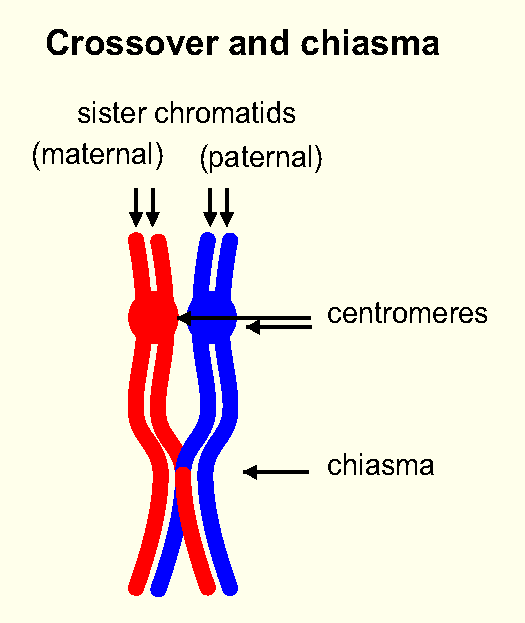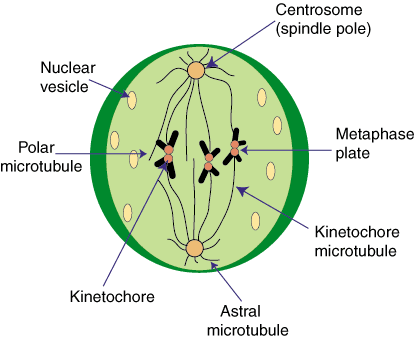 Daily Newsletter
Daily Newsletter
October 25, 2012 Meiosis
On Tuesday, the topic discussed was mitosis. We saw that mitosis was standard nuclear division. When coupled with cytokinesis, we saw that the goal was taking one parental cell and creating two identical daughter cells. With meiosis, we will again experience nuclear division, but with a different goal than mitosis. The goal of meiosis is to produce gametic (reproductive) cells. As such, we will 'always' couple meiosis with cytokinesis.
Goal of Meiosis: From one diploid parental nuclei, generate four genetically unique haploid nuclei.
Goal of Meiosis-Cytokinesis: From one diploid parental cell, generate four genetically unique haploid cells.
The production of gametic cells requires two nuclear division events: a reduction division, and an equatorial division.
Important Note: All forms of nuclear division have the same basic four stages. Prophase is the set-up, Metaphase is when chromosomes align, Anaphase is when chromosome/chromatid seperate, and Telophase is when the nucleus returns to "norm".
The first meiotic divison is a reduction division, and is reffered to as Meiosis I. As the term reduction implies, we are "reducing" something. Specifically, during the reduction division the cell is reducing chromosomal number. REMEMBER: a diploid organism (2N) carries two copies of each chromosome. During a reduction division, the copies are separated and moved to opposite sides (poles) of the cell.
Homologous Chromosomes: This term refers to the two copies of each chromosome. For example: Chromosome 1 in humans is the largest of the chromosomes. Individuals have two copies of chromosome 1:
 one from their mother and one from their father. These two individual examples of chromosome 1 are considered homologous. Homologous chromosomes carry the same genes, but each homolog (one copy) will have a unique set of alleles (one allele for each gene).
one from their mother and one from their father. These two individual examples of chromosome 1 are considered homologous. Homologous chromosomes carry the same genes, but each homolog (one copy) will have a unique set of alleles (one allele for each gene). The image to the right is an example of of two different homologous chromosomes. Notice that at the same gene is found at same location on each homolog (a member of a homologous pair). As shown in the first homologous pair, one homolog carries allele A for the first labelled gene, while the second homolog carries allele a.
 IMPORTANT NOTE: Remember that what we are seeing are chomosomes. The two chromatids of a given chromosome are the products of DNA replication. The image to the left should help you remember that you start with a Maternal DNA molecule and a Paternal DNA molecule. After DNA replication, these will consense into maternal and paternal chrmosomes. It is critical that you remember the difference between Chromosome and Chromatid.
IMPORTANT NOTE: Remember that what we are seeing are chomosomes. The two chromatids of a given chromosome are the products of DNA replication. The image to the left should help you remember that you start with a Maternal DNA molecule and a Paternal DNA molecule. After DNA replication, these will consense into maternal and paternal chrmosomes. It is critical that you remember the difference between Chromosome and Chromatid. Prophase 1 (prophase of Meiosis I) is the most critical stage of meiosis. Prior to the reduction division (which occurs in Anaphase 1), a recombination event will occur between the maternal and paternal chromosomes. Recombination is a genetic event in which homologous genes on two different DNA molecules are swapped between the molecules. A section of each DNA molecule is cleaved and then bound to a new molecule of DNA. The resulting molecules will still have the same genes, but the alleles they carried have been swapped.
Prophase 1 (prophase of Meiosis I) is the most critical stage of meiosis. Prior to the reduction division (which occurs in Anaphase 1), a recombination event will occur between the maternal and paternal chromosomes. Recombination is a genetic event in which homologous genes on two different DNA molecules are swapped between the molecules. A section of each DNA molecule is cleaved and then bound to a new molecule of DNA. The resulting molecules will still have the same genes, but the alleles they carried have been swapped. This recombination event begins when homologous chromosomes are brought together during prophase/prometaphase I. The homologs possess DNA sequence similarities, and are able to bind to each other (the homologs chemically recognize each other). Regions where Cross-Over (recombination) can occur begin to over lap, forming a visible structure known as a chiasma (pl. chiasmata). During cross-over(recombination), alleles are swapped between the two chromosomes, with the end result being genetically unique allele patterns on each chromosome. CRITICAL POINT: the result is two unique chromosomes! This step is critical for maintaining diversity in diploid (eukaryotic) cell systems. Ever generation inheriets a unique genetic composite of maternal and paternal alleles.
This recombination event begins when homologous chromosomes are brought together during prophase/prometaphase I. The homologs possess DNA sequence similarities, and are able to bind to each other (the homologs chemically recognize each other). Regions where Cross-Over (recombination) can occur begin to over lap, forming a visible structure known as a chiasma (pl. chiasmata). During cross-over(recombination), alleles are swapped between the two chromosomes, with the end result being genetically unique allele patterns on each chromosome. CRITICAL POINT: the result is two unique chromosomes! This step is critical for maintaining diversity in diploid (eukaryotic) cell systems. Ever generation inheriets a unique genetic composite of maternal and paternal alleles.This event is one of the most critical ways that eukaryotic organisms ensure the diversity of their populations. Why?
After this recombination event, Chromosomes will line up the equitorial line (metaphase plate) so that there is one homolog on either side of the equitorial line. RECALL: in mitosis, chromosomes lined up so that there was a chromatid on either side of the metaphase plate; now in meiosis I, there is a homolog chromosome on either side. Why is this important?
 |
| Metaphase in Mitosis |
 |
| Meiosis I |
As you can see in the image of meiosis I, the alignment of chromosomes during Metaphase is critical. During anaphase I, the freshly recombined homologs are seperated. The cell moves from a diploid (having 2 sets of chromosomes, 2N), to a haploid state (having only 1 set of chromosomes, 1N). This is the reduction division!
Mitosis II occurs like mitosis, which is classified as an equitorial division. In an equitorial division, the chromatids are seperated. (see the difference?)
 NOTICE: each cell produced in meiosis I now undergo meiosis II.
NOTICE: each cell produced in meiosis I now undergo meiosis II. During the reduction division (meiosis I), you went from a diploid to a haploid state. This is done by aligning the chromosomes in metaphase so that there is a homolog on either side of the metaphase plate. During anaphase, the homologs are seperated.
During the equitorial division (meiosis II), each chromosome is seperated into the individual chromatids. In metaphase II, chromosomes are aligned so that the chromatids are on either side of the metaphase plate (or to put it another way, they are alinged down the centromere). During anaphase II, the sister chromatids are then seperated.
The result: 4 genetically unique haploid cells!
Daily Challenge
We have discussed the main stages of nuclear division, and you have readings from your textbook and supplemental reading on meiosis. In your own words, describe the process of meiosis, complete with a discussion of synapsis, chisamata, and cross-over. Why is the recombination event so critical to population diversity? How could recombination affect evolution?Link to Forum
No comments:
Post a Comment